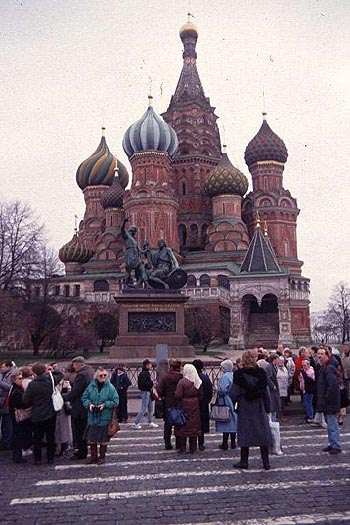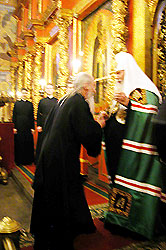|
Russian Heritage International Organisation |
Head Office Moscow - Russian Federation |
|
 RHIO-(PMOH) - Jerusalem Holy Land CenterЦентр Святой Земли Иерусалим Mt. of Olives - Russian Compound - Jerusalem PMOH - Russkie Mezhdunarodnie Obshestvo Nasledie - Mockba  |
RHC Moscow | RHC Berlin | RHC Jerusalem |
 |
 |
 |
 |  |
Their Imperial Majesties - In Loving Memory |

October 7, 2008 - 16:00 RHIO (PMOH) Jerusalem News THE KREMLIN, MOSCOW.- Russian President Dmitry Medvedev held talks with Israeli Prime Minister Ehud Olmert. The Russian head of state emphasised that economic cooperation between the two countries has a solid basis and expressed his hope for its future successful development. Speaking about a Middle Eastern peace settlement, the President declared that Russia will continue to play a constructive and active role in this process. Dmitry Medvedev thanked the government of Israel for its decision to transfer the St. Sergius Metochion in Jerusalem to the Russian Federation. This compound was built by the Imperial Orthodox Palestine Society more than a hundred years ago to receive Russian pilgrims. Three-year talks on the transfer of the St. Sergius Metochion to Russia's jurisdiction ended on 5 October 2008 after the Israeli government made the corresponding decision. The compound requires major repairs and restoration work. In April 2008 10 million rubles from the President's Reserve Fund were tentatively allocated for this purpose. |
 The Russian Orthodox Church in the Holy Land - Historical Overview Byzantine Orthodox Christianity became the state religion in Russia in AD 988. During the eleventh century, Russian pilgrims began to make their way to the Holy Land, but they did not establish their own institutions in Palestine until the 19th century, when pilgrims started to come in their thousands to Jerusalem. After the Crimean War, when the number of pilgrims made a dramatic increase and the Tsar was eager to increase his influence in the region, 32 acres of choice real estate were acquired by the Russians, and the area now known as the Russian Compound was built. The Russian Revolution of 1917 put an end to pilgrimage and also gave rise to a 'Church in Exile' or 'The Church Abroad.' The continuing Patriarchate in Moscow is called 'The Moscow Patriarchate.' Both groups hold property and churches in Jerusalem and, since the greater openness to the Christian faith in Russia, there has been increased dispute over ownership. The authentic voice of a unified Russian Orthodoxy in the Holy Land will be heard soon again, and will assume its proper,lawful place both spiritually and physically in the Holy City of Jerusalem.
|
The Russian Compound - JerusalemThe monumental Russian Compound was built between 1860 and 1864 to serve the many Russian pilgrims, who were at that time more numerous than the pilgrims from any other country. Before World War I, the average annual number of Russian pilgrims was about 14,000 Ė some even made the entire pilgrimage from Russia on foot! All the building materials for the compound, as well as the furniture for the seven buildings, were brought from Russia by a Russian shipping line established for that purpose, which also brought shiploads of pilgrims. The Imperial Orthodox Palestine Society, based in St. Petersburg, was the initiator and backer of the huge undertaking, and Russian architect Martin Ivanovich Eppinger was responsible for its design and building. Spread over 18.5 acres and clearly influenced by Byzantine architecture, the compound consisted of the Cathedral of the Holy Trinity, the residence of the Russian Orthodox religious mission, a consulate, a hospital and separate hostels for men and women, with 2,000 beds. Sometimes tents had to be erected to accommodate the crowds! The Sergei Imperial Hospice, named after Grand Duke Sergei, brother to Czar Alexander III, and then President of the Provoslavic Palestine Association, occupied nine acres of land and was completed in 1889; its 25 luxuriously furnished rooms were intended as lodgings for aristocrats. In 1870, the newspaper "Havatzelet" commented about the hospice: "The new hostel for the Russians, this huge and splendid building, is made entirely out of hewn stone and is one of the most marvelous buildings in our city"; and describes the cathedral as, "a fabulous structure standing on a lofty site." Before World War I, the large courtyards contained stables, storerooms, chicken coops, wells and a laundry. During the British Mandate period, the buildings housed government offices, such as the Public Works Department and the Immigration Office. The Russian Mission remained in one of the buildings until 1967. |
The property, except for the cathedral and one building, was apparently purchased by the government of Israel in the 1960s. These purchases are under legal and diplomatic dispute between the current Russian Government and the State of Israel, and the Russian Government demands a full return of all the property back into Russian hands. The Jerusalem municipality was built here; the Ministry of Agriculture, magistrate and district courts, Jerusalemís police headquarters and a detention facility, as well as the offices of the Society for the Preservation of Nature, are housed in the compoundís buildings. In the former Russian consulate, now part of the municipality complex, the offices of the Jerusalem Development Authority and Moriah (the Jerusalem Development Company) are now located. The Russian compound presents the largest potential site for development in the center of Jerusalem. Current Israeli Plans include a circular public plaza around the cathedral, a shopping center with underground parking and renovation and redesignation of historic buildings. view the latest news on the Russian Compound Dispute |
Prayer for Peace and Unity |  | |
 The Moscow Patriarchate |  The Church Abroad |    |
 |
|


 
 |
" Russia will always be a part of our Being,wherever we are - She will never forget us, nor will we ever forget her. " (HGP) |